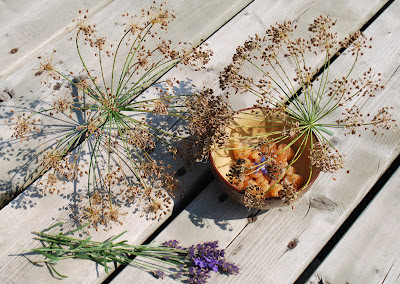Cet article en français.
Este artículo en español.
 |
| The September garden didn't look very pretty, even though it was greener than the past summer, since we finally received rain. |
Last year's similar article :
Hélène :
 |
| One of the pea harvest. |
In April-May of this year, I would have told you that this early-starting season was going to be a good one! Where I am in Quebec, I managed to plant my peas at the very beginning of April, something a bit unusual considering that normally, there's still snow at this period or the ground is still frozen solid. But this year, the weather was so mild!
And then the problems started, first with a serious night frost that took the flowers off my juneberry and cherry trees, canceling my hope for a harvest. In the following month of June, we had a drought. Even with my rain barrel - that remained almost empty the entire summer - my plants suffered. Of course, if I had not been lazy about putting a good amount of mulch, a lot of plants would have faired better (shame on me). Summer nights stayed cold too, a factor that didn't help the growth of plants.
 |
| Even in difficult times, at least the end of October's colors were fabulous: Here's the juneberry, dressed in fire, and the birch in the background sporting a vibrant yellow. |
In the end, the season stopped sooner than expected. At mid-October, two weeks before the usual closing of the season, my most fragile plants of tomatoes and beans browned up and died, most likely due to cold nights.
 |
| Since I don't have many pictures of gorgeous vegetables, I'll show you flowers. The valerian stretched to the border of my balcony. It's a favorite of bees. |
But if one of the major principles of permaculture is defined by having a great variety of plants to subdue the failures of some by the successes of others, I'm really happy to have practiced it; else I would have been pretty miserable. Here's the summary for my 2012 garden season, successes and failures.
Failures : My tomatoes and winter squashes made an OK harvest, however smaller than previous years, but the real losers this year were the beans. I was always bragging about how beans never failed me and how I harvested plenty. This year, besides green beans that my son planted (just enough for 3 meals) and the Edamames (enough for one meal, not much considering I had 5 plants), I harvested only one Scarlett Runner and no Painted Lady (these varieties are normally my pride and joy). My 6 vines of Jacob's Cattle (a cooking bean) only gave me a handful. Talk about a sucker punch in my gardener's ego.
I talked many times already about my fruit trees' failure to produce something, but one I haven't mentionned yet was the golden raspberry patch. Even thought it gave me some fruits throughout the season until november as their usual, it was only a berry or two at a time and their flavor wasn't as good as previous years, acidic and not as sweet as usual. A gardener's snack, no more.
 |
| Rose petals made a delightful harvest aimed at perfuming baths for everyone in the house. |
But were there any successes at all ?
 |
| One harvest of tomatoes and green beans. |
Of course! Peas, as pictured above, gave a lot and the peaches got their own article, but what really shined this year was the root crops. Radishes, carrots, turnips! I got them in quantity.
Flowers also have done extremely well, like the valerian (Valeriana Officinalis), harvested for the root, the calendula, camomile, daylillies or even the dill for the seeds, leaves and flowers! Actually, all herbs did tremendously, from lemon balm to mint!
 |
| One harvest of camomile growing throughout my lawn. They soaked in water to make sure no insect was hidding in them. I make herbal teas out of those. |
Broccolis have been a real surprise for me and will surely become a prized vegetable here in the garden. Cucumbers, althought I harvested only 4 from 2 different varieties, are considered a success since it's the first time ever I manage to get a fruit out of these plants. What can I say, it seems I just don't understand cucumbers, but at least I'm slowly learning. Same for the beets. I harvested only 3 (they were amazingly good) and it is a success considering the poor situation in which I thrust them (right in the turnip patch : result? The turnips won). All in all, if the common wisdom is right about failure as the best place to learn, this summer I seriously took giant steps!
 |
| This year's squash, the Burgess from Veseys, and calendula flowers (Calendula Officinalis) drying in a bowl in the foreground. |
It was my first year with corn, but not any variety! One to make popcorn called Strawberry Corn (I bought mine at Solana). Althought I got only one ear of corn out of the experience, the result was very interesting. I plan to try it in a more serious manner next year!
 |
| A couple of minutes in the microwave and popcorn! My grocery store happened to have this variety of corn too, so I bought more to make a bigger snack. |
 |
| Find the butterflies (Vanessa Kershawi, if I rely on my google-foo) in the mint patch! |
What about the rest?
One astounding thing was the life in the garden this year. There were some new faces (new types of caterpillars, butterflies, beetles and a pair of cardinals, to name a few) as well as old acquaintances (the bees, ladybugs, mice, robins) and out of all this a clear ecosystem is forming! It's beautiful to see, really!




































